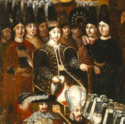Mahfiruz Hatice
| ||||
| ||||
 | ||||
| Dane biograficzne | ||||
| Dynastia | Osmanowie | |||
|---|---|---|---|---|
| Data i miejsce urodzenia | 1590 Czerkiesja | |||
| Data i miejsce śmierci | 1620 Stambuł, Imperium Osmańskie | |||
| Ojciec | Mirza Alkas Bey | |||
| Matka | Feride Hatun | |||
| Rodzeństwo | Sahincan Hatun Fatma Daye Hatun Janhot Bey Ali Bey | |||
| Małżeństwo | Ahmed I | |||
| Dzieci | Osman II Hatice Bajazyd Sulejman | |||
Mahfiruz Hatice[1] (ur. ok. 1590, zm. ok. 1620-30) – konkubina Ahmeda I, matka Osmana II.
Życiorys
Pochodzenie Mahfiruz jest niepewne. Najprawdopodobniej pochodziła z Kaukazu i wywodziła się ze starej, czerkieskiej szlachty. Istnieje też wersja, według której była rumelijską niewolnicą o imieniu Eudoksja.
W haremie nadano jej imię Mahfiruz oznaczające „szczęście” lub „kamień księżycowy”. Była jedną z pierwszych nałożnic Ahmeda. 3 listopada 1604 roku wydała na świat jego pierworodnego syna, przyszłego sułtana Osmana II. W późniejszych latach urodziła władcy jeszcze co najmniej troje dzieci: Bajazyda oraz zmarłych w dzieciństwie Hatice i Hüseyina, niektórzy przypisują jej też Hanzade i Sulejmana. Mimo to, prawdopodobnie nigdy nie uzyskała tytułu Haseki, jako że stanowisko to piastowała „grecka piękność” Mahpeyker Kösem, ulubienica Ahmeda. Kösem skutecznie utrudniała relacje Mahfiruz i jej dzieci z padyszachem, według raportów ambasadorów, jak i podań ludu, kobiety bardzo często ze sobą walczyły. Podczas jednego ze świąt, Mahfiruz oblała włosy Kösem szerbetem za nieokazanie jej szacunku, innym razem Haseki spoliczkowała Czerkieskę. Zanotowano też incydent, kiedy to Mahfiruz została wychłostana z rozkazu władcy. Miała to być kara za rozgniewanie Kösem.
Ahmed wygnał matkę swojego pierworodnego tuż przed śmiercią, a Mahfiruz nigdy już nie powróciła do Topkapı.
Hatice nie miała dobrego kontaktu z najstarszym synem, gdyż małego Osmana odebrano matce tuż po narodzinach i oddano pod opiekę nianiek. Kiedy wstąpił na tron w 1618 roku, nie wezwał matki z powrotem do pałacu, prawdopodobnie też nigdy nie uzyskała ona tytułu Valide Sultan.
Najpewniej została zamordowana z rozkazu Kösem ok. 1620-1630 roku[2][3].
Przypisy
Media użyte na tej stronie
Autor: Nieznany, Licencja: CC BY 4.0
"The enthronement of Sultan Osman II (r.1618-22), by a European artist travelling with the Austrian Ambassador Baron Mollard. The enthroned Osman II is presented facing his mother, Mahfiruz Sultan, the head of the Imperial Harem. She is wearing a gold crown and is surrounded by her maids of honour. The birth of Sultan Osman II marked the moment in which her husband, Sultan Ahmed I, became the youngest Ottoman Sultan to ever become a father. Upon Osman’s enthronement in 1618, she left the old palace (Eski Saray) in the Bayezid district and moved to the Imperial Harem in the Topkapi Palace.
The iconic Ayasofya Mosque portrayed in the background frames the scene and sets the importance of the moment, as do the figures of the müezzins on the minarets who appear to be announcing the call to prayer (ezan). The grand mufti (şeyhülislam) Hoca Ömer Efendi, Osman II’s tutor (hace-i sultani), is situated directly in front of the Imperial Mosque; presenting the holy Qur’an towards the audience and blessing the young ruler. The grand mufti was one of the leading political figures behind the dethronement of the previous Sultan, Mustafa I (r.1617-18 and 1622-23), paving the way for Osman II’s ascension to the throne. The musicians and dervishes surrounding Hoca Ömer Efendi were most probably from the mevlevi dervish lodge, and appear to be performing a Sufi ritual (mevlevi ayini) in order to obtain a divine blessing for the recently enthroned Sultan. The chief-black-eunuch of the Imperial Harem (kızlar ağası), Süleyman Ağa, is depicted beside the Sultan as his duty was to accompany the prince to the throne and supervise the ceremony. The sword-bearer (silahdar ağa) is positioned behind him, holding a bejewelled box which was to be presented as an imperial gift to the Sultan. The sword-bearer’s responsibility was to escort the prince from his private chamber in the Topkapi Palace to the throne. Wearing a red kaftan behind him is the solak (imperial guard), guarding the enthroned monarch. In front of the Emperor’s mother appears the grand-vizier, Sofu Mehmed Pasha (d.1649), holding a mace.
The Austrian ambassador, Baron Hans Mollard von Reinek, is painted in distinctly European attire with a large feathered hat. Below the enthronement scene are the various members of the public and imperial chancery who have gathered in order to take part in the ceremony".